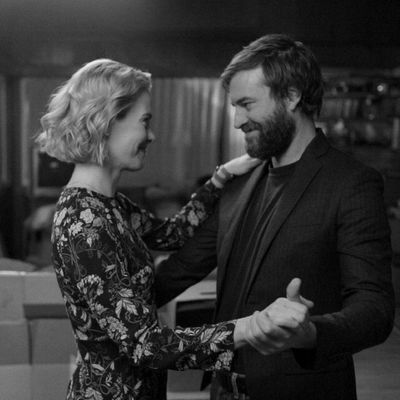
Blue Jay, the first movie produced under the Duplass brothers’ Netflix deal, has been marketed as the Pacific Northwest version of Richard Linklater’s Before Sunset, and the similarities aren’t hard to see — the film is a rambling walk-and-talk picture about two former lovers, Jim (Mark Duplass) and Amanda (Sarah Paulson), reuniting and reliving their youthful romance. But while Blue Jay shares the joy and heartbreak that helped make Linklater’s film a classic, the last 15 minutes of the film provide an additional twist.
Spoilers for Blue Jay below.
When Jim and Amanda run into each other in the condiments aisle of their hometown grocery store, the former high-school sweethearts haven’t seen each other in two decades. Jim recognizes Amanda but he doesn’t say hello — the first sign that something isn’t quite right. But over the course of the film, the pair’s initial awkwardness gives way to a special kind of rhythm, one that shows the power of chemistry and nostalgia.
In the film’s final few minutes, though, we learn that Amanda had an abortion during her initial relationship with Jim, and the deep wound the pair share is the result of that choice. Though neither character actually says the word abortion (given the Duplasses’ improvisational style, this was likely not a conscious move), the memory of Amanda’s decision moves Jim to hysterics. “That was my baby, too,” he shouts. “It was ours … Why did you do that?” He throws a chair and pulls his hair, frustrated that he’s just spent the last several hours playing out a fantasy life with the woman he’s been fixated on for years. “It was our life,” he says. “We were going to be so happy. We lost it.”
In Blue Jay, Amanda’s abortion serves as a wake-up call, a reminder that you can’t ever really be young again — that there are choices in life you can’t take back. At the same time, the reveal underpins an argument for emotional vulnerability. Amanda’s decision turns out to have hinged on a note she found in Jim’s home. The first version of the note told her they’d make it through her pregnancy together, that he loved her more than anyone else. But he didn’t send it; instead, he left her a sarcastic message filled with off-color jokes. With that, Amanda made her decision: They couldn’t handle having a child. By the end of the film it’s clear that if Jim had sent Amanda his original note, if he’d been open and honest, their lives would have been different. What happens next is the film’s boldest move: Amanda admits that yes, sometimes she does regret her choice.
It would be too easy to interpret Blue Jay as a cautionary tale, one that antiabortion activists could point to as validation. In Paulson’s capable hands, showing the emotional effects of Amanda’s decision isn’t an argument against abortion; it’s simply recognizing its weight. In showing her regret, the film allows her the space to reflect on what her life could’ve been, to feel the sadness that comes with knowing it won’t ever turn out how she might have hoped.
That uncomfortable mix of emotions sets Blue Jay apart from previous abortion stories, most of which follow characters who are weighing their options — they’re over once the woman’s decision has been made. This kind of arc has a dramatic advantage: In the emotional push-pull between pregnancy and abortion, the stakes are inherent. Think of Alexander Payne’s 1996 satire Citizen Ruth, which skewers both sides of the abortion debate, showing the absurdity of trying to control women’s decisions. Even with the film’s laser focus on abortion, Laura Dern’s Ruth Stoops’s feelings about her pregnancy are overwhelmed by the media firestorm that surrounds her. In both 2014’s Obvious Child and 2015’s Grandma, the characters only get the opportunity to express their raw emotions when they’re on the table, about to get the procedure.
All of those films were positioned as “abortion stories.” What makes Blue Jay stand out is the surprise of the reveal: Here, abortion is a normal part of life, as it is for the 30 percent of women who will have an abortion by age 45. Considering that figure, it’s odd that abortions rarely come up in film (TV has been better), possibly because women are not given the tools to talk about them. The point is made briefly in Jill Soloway’s 2013 Sundance winner Afternoon Delight, in which Kathryn Hahn’s Rachel ruins a party by bringing up an abortion she had in college, refusing to drop the subject even though the room has gone cold. It’s a small moment, but the film lingers on the discomfort she causes; in a room full of friends, it still isn’t safe for Rachel to broach the topic.
It’s important to show these moments, even if they’re uncomfortable, even if they’re messy, even if they’re taxing. With many states across the country moving to restrict abortion access, it’s natural that most art around the subject treats it as a political talking point rather than as part of an emotionally complex narrative. But though not every woman (or man) has complex emotions around their abortions, when you limit abortion stories to a certain set of rules, a certain amount of humanity is stripped from the experience. And it’s that humanity, in Paulson and Duplass’s hands, that makes Blue Jay so genuine, and so worthy of praise.




